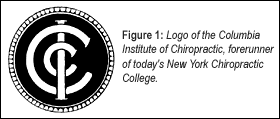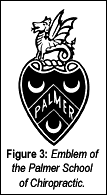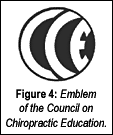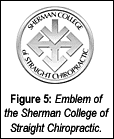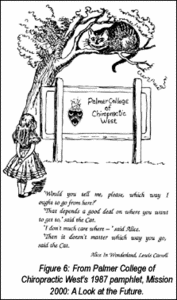Chiropractic schools differed in the basic science instruction they offered, including subjects covered, depth of coverage (e.g., with or without dissection and laboratories) and length of training. They also varied greatly in the clinical training they provided. Some restricted their curricula to subluxation detection and correction, and others offered a smorgasbord of "drugless" and naturopathic healing methods. Although some degree of consensus congealed in the post-WWI era for an 18-month course of instruction, Palmer insisted that "three years of six months each" was a maximum of time needed to manufacture a chiropractor. Many, if not most others, considered 18 months a minimum. The chiropractic colleges, state associations and the various BCEs battled one another for decades, over "standards" for chiropractic training. The Palmer School of Chiropractic did not abandon the 18-month curriculum until the 1950s, at which point most BCEs required a good deal more instruction as a prerequisite for licensure.
The dispute over the education of the DC did not end with the federal government's recognition of the Council on Chiropractic Education (CCE) as an accrediting authority for chiropractic schools in 1974 (Keating, et al., 1998b). For the next two decades, a number of nouveau straight chiropractic educators (Strauss, 1994) would continue to press for a nondiagnostic, nontherapeutic version of the chiropractic art. Although compromise with the CCE was reached in 1995, the underlying sentiments persist, reinforced perhaps by platform speakers who extol subluxation detection and correction for its "innate-freeing" potential. (Ever heard the saying, "Innate knows more than any diagnosing fool"?) In a few jurisdictions (e.g., Michigan), the DC's legal responsibility to diagnose is minimal, which may help to perpetuate this historic aversion to comprehensive patient assessment and triage.
The diversity in chiropractic thought is reflected also in the wide range of attitudes toward science, logic and epistemology (Keating, 1997). Once upon a time, research was widely equated with marketing, and was pursued as a means of increasing patient volume (Keating, et al., 1995). Concurrently, the science of chiropractic was said to be a "deductive science" (Stephenson, 1927), which shunned the inferential reasoning of empiricism for the seeming certitude of deduction from "true" first principles. Still common today is the idea that research is needed to determine "how and why chiropractic works so well," rather than to explore what works for which patients with which problems. Alternatively, research is often extolled as a means of validation, i.e., to "prove what we always knew was true."
Probably a minority in the profession today reject scientific research as "medical," although such assertions can still be heard among doctors who believe that a century of private clinical experience is sufficient to substantiate the art. Some profess that a science of chiropractic is such a different creature from other healing arts that the traditional rules of evidence in science do not apply. Occasionally, the founder's notion that chiropractic is superior to "godless" medical science because it unites the "material and the immaterial" can yet be heard. A revival of interest in vitalism as a basis for chiropractic (as expressed at the Conference on Philosophy in Chiropractic Education held in Fort Lauderdale in November 2000), suggests a return to D.D. Palmer's theosophy of chiropractic (Palmer, 1910, 1914).
Ironically, these notions have persisted, despite a burgeoning research enterprise within the chiropractic profession (e.g., Gitelman, 1984; Keating, et al., 1998a). The gulf between the field-at-large and the isolated pockets of scientific expertise and productivity has been large, and it is not clear at this moment whether it will shrink or grow or remain constant. Some political successes have been attributable to the growth of scientific evidence, but efforts to expand the number of qualified chiropractor-scientists have been meager. The formation of a federally funded Consortial Center for Chiropractic Research at Palmer College/Davenport bodes well for further investigations, but simultaneous efforts to block the formation of state-university-based and state-funded chiropractic schools seems to augur in the opposite direction. Chiropractors have tested some of their hypotheses concerning the value of adjusting for patients with low back pain, and the results have generally been favorable. Yet such successes have paradoxically fueled concerns that research will limit the profession to a musculoskeletal specialty provider role. Meanwhile, as a few research-minded chiropractors lower their traditional guard to pose and test null hypotheses related to chiropractic theories, official chiropractic persists in promoting unsubstantiated claims (e.g., Grod, et al., 2001).
In his 1944 manifesto, C.O. Watkins, DC, former chairman of the board of directors of the NCA (1942-43) and first chairman of NCA's Committee on Education (forerunner of CCE; 1935), bemoaned the lack of consensus about fundamental issues in chiropractic:
| During the years of my association with chiropractic government, I talked to many leaders of chiropractic schools and organizations. Their concepts of the purpose and methods of government which would advance chiropractic represented such a confusion of methods taken from the fields of business, politics, religion, and science that when one thinks of chiropractic leadership as a composite leadership, he is reminded of the general who became so confused that he mounted his steed and endeavored to ride off in all directions simultaneously (Watkins, 1944). |
He offered a decidedly minority view about the basis for a united profession:
SPECIFIC PROPOSALS
Recommendations to National Chiropractic Association and Other Chiropractic Organizations
- It is proposed that chiropractic organization conform to the principles, methods and attitudes of science in any program sponsored under the name of chiropractic.
- It is proposed that national chiropractic organizations and other chiropractic organizations able to do so develop scientific organizations for the purpose of organizing clinical research throughout the profession; that a clinical research director capable of organizing clinical research throughout the profession be employed; and that a program for developing field leadership in clinical research throughout the profession be developed.
- It is further proposed that it be declared the ethical responsibility of every member of the chiropractic profession to share his knowledge with his colleagues freely and without hope of financial remuneration.
- It is further proposed that a course upon the principles, methods, and attitudes of science be made a part of the basic education of the students in all chiropractic educational institutions.
- It is further proposed that legal talent be obtained which can adequately defend the right of chiropractic as a science to progress unhampered by legal restrictions, insofar as it is possible.
- It is further proposed that all chiropractic organizations recognize scientific organization as the basic purpose of organization in a clinical science, and that they devote the greatest effort possible to bring about a responsible organized science of chiropractic (Watkins, 1944).
Forty years later, the president of Palmer College of Chiropractic West seemed to echo Watkins' concerns about the diversity of chiropractic ideas, when he suggested that a first condition for planning the profession's future must be to decide very clearly what a chiropractor is (Miller, 1984). The need for consensus on so fundamental a question as "What is a chiropractor?" was also reflected in that school's December 1987 projections for the institution's future, entitled "Mission 2000: A Look at the Future."
The chiropractic profession in this country has always been multi-minded. Some see this diversity as strength, while others see it as a stumbling block to planning for a brighter future. Some, like Chairman Watkins, believed that the profession should mature and unfold on the basis of its own clinical science, established by chiropractors in the interest of ever-better patient care, but with a commitment to cooperate with other health sciences and professions. Others no less adamantly insist that the profession's priority is to retain and reiterate the "truths" established by the founders, to preserve "the chiropractic principle in its purity for posterity," so that the "wonders of chiropractic" will not be lost to future generations. Some believe that the profession's identity is or should be bound up in its commitment to unvalidated (largely untested) lesion hypotheses and vitalistic premises.
A few DCs would shear the profession of its historical baggage and seek an identity based upon clinical research and evidence-based practice. Some chiropractors wish to integrate with the wider health science community, while others believe it is better to remain isolated from the mainstream, so as not to be tainted, absorbed or eliminated by the allopathic Big Brother. Many, perhaps even the majority who occupy the center region of the normal distribution described by sociologist Walter Wardwell (Wardwell, 1992a, p. 257), seem to remain undecided, conflicted or unconcerned. This latter notion is buttressed by the continuing reality that most DCs are not members of any national association of chiropractors.
The more things change, it seems, the more they stay the same. Chiropractic in America today stands in pretty much the same place it has throughout its first century: determined to survive but ambivalent about who it is and where it wants to go. Forces within the profession continue to pull in multiple, frequently opposite directions. The whole is weakened by these fractures, and rendered vulnerable to many still hostile elements within the medical fraternity. Accordingly, the foreseeable future of this healing art, as has been the case in the past, will probably be shaped by the profession's reaction to external forces, rather than to proactive decisions based upon a shared view of chiropractic and the chiropractor. We have a long way to go - but which way?
- Beideman RP. Seeking the rational alternative: the National College of Chiropractic from 1906 to 1982. Chiropractic History 1983;3:16-22.
- Brennan MJ. Perspective on chiropractic education in medical literature, 1910-1933. Chiropractic History 1983;3:20-30.
- Budden WA. Medical propaganda aided by B.J. Palmer defeats healing arts amendment. The Chiropractic Journal 1935 (Feb);4(2):9-10,38.
- Caster CE. "B.J. admits chiropractic is doomed." from the American Medical Journal, March 17, 1928. Hawkeye Chiropractor 1928 (Apr);3(5):1,5.
- Gevitz N. "A coarse sieve": basic science boards and medical licensure in the United States. Journal of the History of Medicine & Allied Sciences 1988;43:36-63.
- Gibbons RW. Minnesota, 1905: Who killed the first chiropractic legislation? Chiropractic History 1993 (June);13(1):26-32.
- Gitelman R. The history of chiropractic research and the challenge of today. Journal of the Australian Chiropractors' Association 1984 (Dec);14(4):142-6.
- Grod J, Sikorski D, Keating JC. The unsubstantiated claims of the largest state, provincial and national chiropractic associations and research agencies. Journal of Manipulative & Physiological Therapeutics 2001 (Oct); 24(8):514-9.
- Keating JC. C.O. Watkins: pioneer advocate for clinical scientific chiropractic. Chiropractic History 1987 (Dec); 7(2):10-5.
- Keating JC. The influence of World War I upon the chiropractic profession. Journal of Chiropractic Humanities 1994;4:36-55.
- Keating JC. Chiropractic: Science and antiscience and pseudoscience, side by side. Skeptical Inquirer 1997 (July/Aug);21(4):37-43.
- Keating JC, Green BN, Johnson CD. "Research" and "science" in the first half of the chiropractic century. Journal of Manipulative & Physiological Therapeutics 1995 (July/Aug); 18(6):357-78.
- Keating JC, Caldwell S, Nguyen H, Saljooghi S, Smith B. A descriptive analysis of the Journal of Manipulative & Physiological Therapeutics, 1989-1996. Journal of Manipulative & Physiological Therapeutics 1998a (Oct);21(8):539-52.
- Keating JC, Callender AK, Cleveland CS. A History of Chiropractic Education in North America: Report to the Council on Chiropractic Education. Davenport IA: Association for the History of Chiropractic, 1998b
- Miller JL. From the president. Palmer/West Magazine 1984 (Sum);2(1):2-3.
- National (College) Journal of Chiropractic 1928 (Dec);5(14):12.
- Palmer DD. The Chiropractor's Adjuster: The Science, Art and Philosophy of Chiropractic. Portland OR: Portland Printing House, 1910.
- Palmer DD. The Chiropractor. Los Angeles: Beacon Light Printing Company, 1914.
- Stephenson RW. Chiropractic Textbook. Davenport IA: Palmer School of Chiropractic, 1927.
- Strauss JB. Refined by Fire: The Evolution of Straight Chiropractic. Levittown PA: Foundation for the Advancement of Chiropractic Education, 1994.
- Turner Chittenden. The Rise of Chiropractic. Los Angeles: Powell Publishing, 1931.
- Wardwell WI. Chiropractic: History and Evolution of a New Profession. St. Louis, Mosby, 1992a.
- Wardwell, Walter I. Chiropractors' struggle for legal recognition: balancing rights and protections. Chiropractic History 1992b (Dec);12(2):25-31.
- Watkins CO. The new offensive will bring sound professional advancement. The Chiropractic Journal (NCA) 1934 (June);3(6):5,6,33.
- Watkins CO. The basic principles of chiropractic government. Sidney MT: the author, 1944; reprinted as Appendix A in: Keating JC. Toward a Philosophy of the Science of Chiropractic: A Primer for Clinicians. Stockton, CA: Stockton Foundation for Chiropractic Research, 1992.
Joseph Keating Jr., PhD
Phoenix, Arizona
Click here for previous articles by Joseph Keating Jr., PhD.






